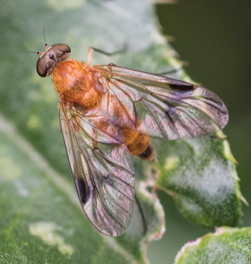
July 1st – A cloudy start to the day but with sunny and windy spells often together especially when my lens is pointing at an insect… The same continuing theme from earlier months! I walk straight through Richmond Park from Kingston to Ham Gate and then go out into Ham Common Woods starting in the sheltered flowery spot to the right of the Gate. The sun is not shining on this area but even so I have a quick look at the Knapweed and Thistle flowers and see a few bugs, Bumble and other bees but not much else other than a medium size fly which is nearly all orange and with some black spots on the wings. It does not appear to be in the books I have which is a little frustrating as I seem to have lost internet access via my neighbours so cannot check Naturespot (and when I do several days later there is no obvious match with this fly!). However on further checking it turns out to be a Tree Snipe-fly (Chrysopilus laetus), a nationally scarce, near threatened species.
My first Large Red Damselfly for some time is also found in the same area but deciding to take the long way around I take the path into the woods that leads away from the road and where the sun appears to be shining. I see lots of Marmalade Hoverflies many trying to defend sunny spots and on a Bramble flower is the large hoverfly readily recognised as Volucella pellucens which allows me to take a few photos and then there is a small, red-eyed hoverfly with a black body with grey markings, a Platycherius species.
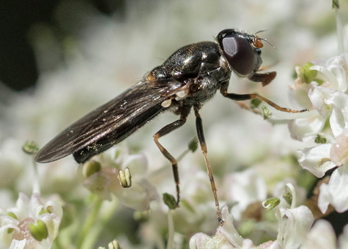
The cloud comes over and so most flies and other insects appear to disappear as I follow the path through this side of the Woods back to the road. The only insects are mosquitoes which have decided I am their prime, actually their only, target. I bat them off and leave the Woods to cross the road and then walk along passed the open area to the sheltered spot where the umbellifers are still flowering and there are also some Brambles in flower.
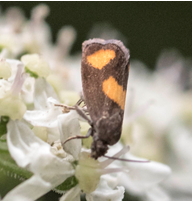
– Pammene aurana
Apart from bees on the Bramble there are not many other insects around with the exception of two Cheilosia species, one large with orange antennae and then there is a smaller one along with a tiny moth, probably about 5mm in length which is brown with orange spots. Again it looks as if it should be easy to identify but appears not to be in my books although it proves to be a Tortricidae moth, an Orange-Spot Piercer (Pammene aurana).
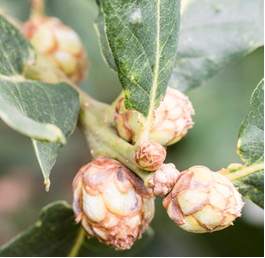
I spend a little time at this spot before moving to the open area because I need to photograph the marble and artichoke galls. Using the camera mounted on a tripod this is done and I also take a few shots of a leaf mine, there are a few of them of the Oak leaves. Two kids on bikes berate me for “damaging nature” because I take a couple of Oak leaves covered with galls to photograph on the light box at home.
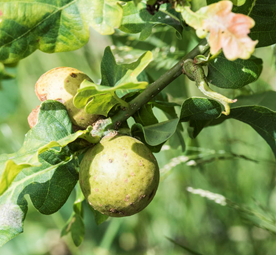
Fortunately I am not an insect collector (although I understand the need to do so in order survey the fauna of an area) because I can imagine how they would have reacted if they had seen me netting and collecting insects! I could say something about helping remove the parasitic load from the Oak tree but do not think it is worthwhile to do so.
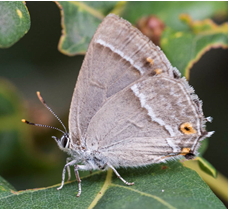
The male bees are still flying around and when I check the nest holes it seems most have occupants today, their faces peering out before my movement causes them to retreat back into their nests. Most of the wasps and bees seen are Cerceris species and all the ones I get to see in the nest holes are the almost totally yellow faced one, C.rybyensis. A few hoverflies and unidentified micro moths are seen at the same spot and then there is a Purple Hairstreak showing very well. It lands and opens its wings so enabling a few shots to be taken and later on it does the same again but this time landing at face height on an Oak stem. It is wonderful to see this butterfly but although it is a rarity to me having spoken to another naturalist in the Park it seems they really are common with a local Butterfly Conservation group counting 300 in the Oak trees over Sheen way! The discrepancy can be readily explained as they look up into the trees with binoculars whereas I tend to be looking down to photograph rather than just to see things.
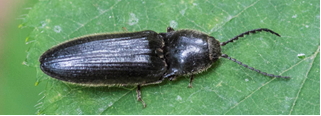
There is a Large Skipper nicely perched by the marble galls, which are on a prostrate Oak “bush”, it can not be over two feet high but is wider than that being spread over about three or four feet so is more of a bush than a tree! This butterfly is really beautiful when you get to have a good, close look at them. This one stays put for some time and does not react to my presence at all which makes a pleasant change, butterflies tend to fly off as soon as they see me… After wandering backwards and forwards for a while around the nest holes and only seeing in addition to what has already been mentioned a single Xanthogramma pedissequum flying low to the ground as they usually do. It does not land but “floats” off into the vegetation. I walk back towards Ham Gate as the clouds gather and find a Comma trying to sun itself and then there is another on a Bramble flower. There is not much else other than a black Click-beetle, several are seen and also a couple of Robber-flies, including Choerades marginatus once more. They allow photographs to be taken but are in awkward places amongst the Brambles so unfortunately getting a good angle is not possible but I try anyway.
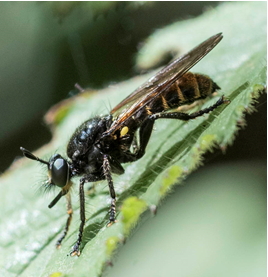
By the time I get back to the first spot just outside Ham Gate the clouds have really thickened and although some time is spent amongst the flowers again there is not much that settles in the open. The Megachile bees are around, whining and flitting from one Knapweed flower to another, single Large and Small Skippers appear on the same plant and on a Thistle flower there is the same mirid bug as yesterday along with yet another Conopid fly, again Sicus ferrugineus. I cannot believe how common they are although I still have to get a decent photo of one, the wind is blowing, the clouds are thick and the light levels are low so the shutter speed is 1/60 second at best. Not good for close up shots where I reckon I need a 1/500 second shutter speed at least to stand a chance of getting a sharp shot. The tripod helps when the insects decide to remain stationary and I get lucky with a Strangalia maculata because it remains perfectly still on an Ox-eyed Daisy, although the flower does not stay so still…
With the light levels being rather low it is time to head home so I do so. There are some rain drops on the way back through the Park but the sun is shining once more by the time I get home. I get delayed in the Park because I start talking to a tree surveyor, one of the Friends of Richmond Park that survey for the Oak Processionary moth. Apart from the Purple Hairstreak information mentioned earlier he tells me that the Oak trees on the stretch between Ham and Kingston Gate have been treated with pesticides for the past few years and the number of Oak Processionary moth nests has dropped from 300 to 30 although this year the spraying did not happen hence the reason for the survey, the Park authorities are concerned the numbers may go up again!
It has been another four hour plus stint out in the open and an enjoyable one. I am pleased to be home because at about 15:00 hours the clouds thicken again and there is a short sharp rain storm although no thunder or lightening accompanies this downpour.
July 3rd – my daily walk starts in Kingston town centre today as I have to go there to use the internet in Kristal (the printers I use). From there I head down to the River Thames and see a few birds including a single Great Crested Grebe (still with stripes on its head so one of this years brood), the Red-Crested Pochards on the river along with the normal Pied Wagtails, ducks, swans and geese. There is a small patch of Fleabane in flower but it is too windy at this spot to attempt to photograph any insects on the yellow flowers.
And then I go into Canbury Gardens to visit the large patch of Thistles next to the rose bushes but I am too late, literally too late, as there are two men chopping them down and tidying up the cut Thistle plants. My aim of photographing lots of insects on Thistles is therefore thwarted before it begins. If only I had gone a few days ago or even yesterday but so be it. Walking along the river towards Teddington Lock proves to be a little disappointing too as the Hemp-Agrimony is just coming into flower along with the yellow Rose of Sharon and there only a few bees on the flowers. One Enallagma is seen but few other damselflies and the clouds and blustery wind does not help with the insect count. Still the sun is shining a mile or so later when I get to Teddington Lock. There is a lot of Yarrow flowering here but few insects seem to use it, just a few bees, so I head for the spot where the Hogweeds were growing before. They are still there and there are a lot more in flower which is good news because there are also insects on them. There appears to be at least one Myathropa florea on each plant although not necessarily one on each flower head and there are other hoverflies including Eristalis pertinax, Syphrus ribesii (male and females noted), Marmalade Hoverflies and even a few beetles including a Rose Chafer and unsurprisingly Strangalia maculata. There is also a single large wasp on the Hogweed, a Bee-Wolf (aka Bee-killer), Philanthus triangulum, which in previous years I have come across nesting in large aggregations on the South Coast near Seaford and on the Hemp-Agrimony in Isabella Plantation. This one does not seem to be hunting but is feeding on the flower head.
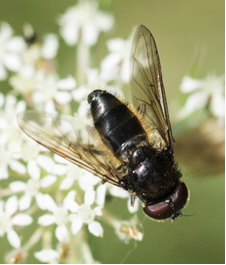
I spend some time around in this spot before moving onto Ham Lands which I have not visited before and where I find several black hoverflies on an umbellifer (not a Hogweed this time) all of which appear to be the same Cheilosia species. This is a hairy eyed species which I cannot identify. A small dark, hoverfly with bright red eyes may be a Chryogaster species but I am not sure of this and the photograph does not help either not being clear or sharp enough!
The part of Ham Lands I visit is an open area surrounded by trees, not a large area but it has flowers such as Knapweeds, the Hogweeds plus other umbellifers, Yarrow, Thistles, Mallows, Tufted Vetch, clovers, Bird’s foot-trefoil, Hop trefoil, Lucerne and a several patches of pink Peas (Lathyrus species). There are many bees mainly orange and white tailed Bumble Bees but others too including some rather small ones which I doubt I will ever get to identify. Some ichneumon wasps are seen and there are also several Solitary Wasps floating around searching for prey or mates I presume. One suddenly lands on a flower and attacks a bee virtually jumping on it and then bending its abdomen to sting the prey before flying off a few moments later carrying the bee with it.
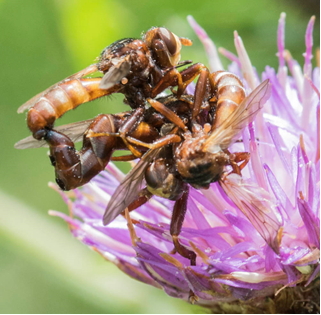
Another pleasant surprise is to see a trio of mating Conopid flies, this really is turning into the year of the Conopid. It is the same Sicus species yet again and the trio look a little bizarre as it seems the “hooked body” of the female has to be turned sideways so the male can mate with her and there are two males, one who is mating and the other who refuses to take no for an answer! The trio move around a Knapweed flower for a few minutes before they fall off into the grass still joined together. A single Conopid fly is seen a bit later in the same area so may have been one of this group and yet another, a female, is also seen on a leaf as I leave the area so is probably not one of the three mating ones. I really cannot believe how often I am seeing Conopid flies this year compared to others. It is quite amazing even if they all are the same species and it makes me wonder if this should be called the “Year of the Bee-grabber”.
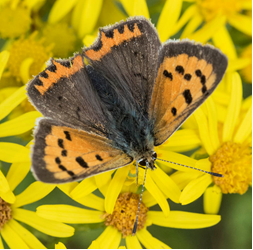
Butterflies also feature well today with Meadow Browns posing nicely on Knapweed as does a Marbled White. There is a Red Admiral, Comma, a stunning looking, fresh, imago Peacock (a most underrated and beautiful butterfly), Large and Small Whites, Small Skippers (common), Small Heaths and even a Small Copper, my first of 2020. However there is no sign of any Common Blues. A few of the small “grass” micro-moths are disturbed but not photographed.
Other insects seen in this area include several individual Soldier-Beetles (Rhagonycha fulva), a Mirid bug (Closterotomus trivialis once more), Ladybirds including 7 and a 14 spot, and two Banded Agrions, large metallic blue damselflies where the males have the dark marked wings resting on bushes. I would stay longer but the wind is blowing and the clouds are gathering and it is a 45 minute walk home. The forecast is for some showers and I wish to avoid them if I can so about 13:15 hours I head back along the path towards Ham and go home after a successful four hours and now I know where they are Ham Lands will be worth revisiting!
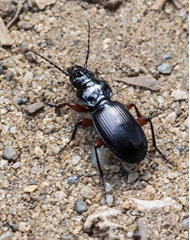
July 4th is not a good day, grey and windy with rain in the air although it does not actually rain much it is mainly spent indoors. July 5th starts off sunny with clouds but with vicious blasts of wind so although it feels warm when the sun shines which it does for most of the day once in a while a fluffy white cloud blocks the sun and it cools down. The wind is a real issue today and it is not pleasant when it gusts up to 35 or 40 miles an hour (according to the BBC Weather forecast). Even so the temperature when the wind allows rises to about 21C. After a Costa coffee from Sainsbury by the station and a stop outside the pub to use the internet (although the pub remains closed until 20th the internet can still be accessed outside!) I head through Kingston Gate and go in the direction of Ham Gate as my aim is to visit Ham Common Woods again, and possibly Ham Lands but as it turns out I do not make it that far. Less than 100 metres into the Park I notice a black, shiny, ground beetle running across the path so I try to get some photos but it refuses to stay still for long enough. The shots I get are all blurred but I can see that the femurs are red-brown and so maybe an ID will be possible. After this minor excitement I carry on to Ham Gate and check out the wooden fences around the pond. There is a social wasp scraping off wood, a few flies including a small, dumpy 5mm long one that looks intriguing (a Phasia sp) and a Robber-fly but nothing really special unless that fly turns out to be…
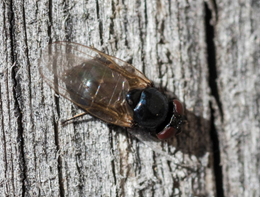
Outside the Gate I check the flowery patch previously described but the sun is still not on this spot and the flowers are moving a lot in the breeze so I only spend a few minutes here before heading off through the woods, heading right once more to have a look at the Brambles which looked the other day like they may have had some good insects when the sun shone on them. It is not very productive following this path but there is the hoverfly Xylota segnis which remains stationary, well it moves around a leaf but does not fly off which they normally do and there is Myathorpa florea, Marmalade Hoverfly and Speckled Woods so not great but something to photograph along with a Green Shield Bug.
Crossing the road I get to across to the umbellifer patch where there are a few insects such as Syrphus vitripennis, Cheilosia hoverflies, Cerceris rybyensis, an Emperor dragonfly, various Robber-flies (Dioctria types) and maybe there are several species as they vary in size, one looks a lot larger than the other and one has bands on orange hairs on the abdomen whilst the other seems to have reddish underside – see notes at end of July) and there are a few butterflies around too. During the morning I see Large White, Red Admiral, Meadow Browns, Ringlets, Small Heaths, Peacock, Large Skipper and lots of Commas. There is also a Holly Blue and once I see one I see at least half a dozen more so the second brood of the year is well and truly on wing now.
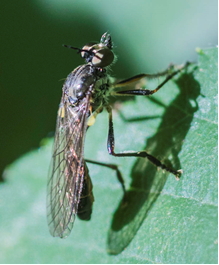
I check the open area for hymenoptera but struggle to get close to any bees or wasps other than a couple of the Large Shaggy Bees and Cerceris rybyensis but there is no sign of any Cerceris arenaria. A good look over the Oak leaves and stems does not prove worthwhile with only a single Dioctria seen but even that is hard to photograph due to the wind causing branches to move, a feature of the day and even the weather forecasters are saying how unusual such strong, gusty winds are at this time of year. The mystery of the spider webs on the Gorse is solved when I see Pisaura mirabilis on a couple of what I am calling webs but which I probably better described as nests, P.mirabilis is an active hunter rather than a web spider and uses the web to raise its young. The only other common insect today is Strangalia maculata which seems to be everywhere and it is interesting to see that some individuals are definitely yellow and black others I would describe as orange and black, the “yellow” part certainly being darker in these ones. No other beetles are seen, not even any ladybirds but maybe that is due to me not looking too hard for them.
So having spent some time out and about (four hours or so) I decide it is time to head home checking the flowery spot just before Ham Gate on route and see a Marbled White on the same Thistle as a Megachile bee. Checking the Knapweeds and Thistles is a waste of time as the wind is too strong and even if there is something spectacular on them getting a photo will be impossible. The walk to Kingston Gate proves unproductive apart from a few Large-Headed Resin Bees at their normal spot but nothing else.
I get home about 2PM and it seems to be a shame to be home so early given the sunshine but due to my own stupidity in not taking any water there is not really a lot of choice and after that the howling wind makes it a strange and not too pleasant an afternoon to be home.
July 6th – the day starts sunny with nice fluffy white clouds but soon clouds over. I take a chance after listening to the weather forecast and go for a walk towards Ham Gate once more. There is nothing of interest noted in the Park but I only really check a few wooden fences as the light is not very good and the wind makes it difficult to focus on plants. However once outside Ham Gate and back in the flowery spot the weather improves with blue sky appearing every now and again and when the sun shines it get warm very quickly. I check the flowering Thistles first and they are covered with the orange-red Soldier-Beetles (again the common Rhagonycha fulva). Two days ago there was only one or two but today there are two dozen at least, which does not surprise me as I often see large concentrations of these Soldier-Beetles most summers. Some are mating but most are feeding on the flowers or just flying around.
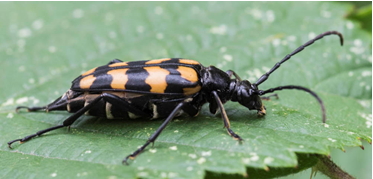
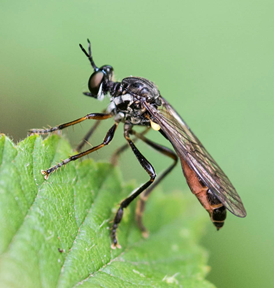
Under the Thistles and on a Bramble leaf there is a rather striking long-horned beetle with what appear to be four black stripes across a dark orange-yellow background. There is no obvious match in my books and it may be a variant of Strangalia maculata which again is common with several individuals flying around or feeding on the Thistle and Bramble flowers but after looking online the identification is clear cut – this is Leptura (formerly Stangalia) quadrifasciata with the common name of Four-banded Long-horn Beetle (a rather adapt no doubt made up common name). The mirid bug seems to be on the same flower and a single Poecilobothrus nobilitatus fly is noted sitting on a leaf. The small group of this fly are still to be found at the water spot in the Park previously mentioned and it seems strange to think these really do walk on water, I see them doing so. It does not look to promising so I check the other side of the stream and see a nicely perched Dioctria robber-fly which is photographed. Low to the ground I notice the red berries of Cuckoo Pint have appeared and once I see the first plant I notice several more. Although the blackberries are forming on the Bramble they are in most cases no where near ripe being green and red at the moment.
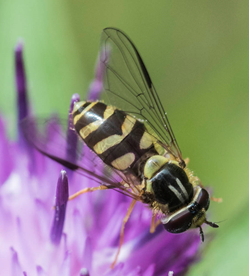
Deciding I have to go home by 4 because of having forgotten to bring my eye-drops with me once again I go back into the flowery area and nothing much appears on the Knapweeds except for a Megachile bee and a Small White butterfly. And then the sun shines for a few minutes. There is insect activity all over the place and it is hard to know what to try to photograph first. I get shots of a hoverfly that I think is a Syrphus species but it turns out to be Dasysyrphus albostriatus with its clear elongated black stigma on the wings and two short grey stripes on its thorax, a tachinid fly which turns out to be Eriothrix rufomaculata with red patches on its hairy, black abdomen, bees including various Bumble Bees and the Megachile ones which have been seen on nearly all previous visits are also flying and feeding along with some Marmalade Hoverflies.
A small black fly lands on a Knapweed and I get a couple of shots. It appears to be a hoverfly, the same Pipiza species (cf. P.noctiluca) with the dots on terites 2 that I saw in the garden back in May. There is so much activity that I struggle to get shots of all I see and then the cloud comes over and the spot quietens down very quickly. With such a good burst of activity I feel pleased to have gone out on a whim and then there is another familiar insect, a Bee-grabber, a Conopid fly, Sicus ferrugineus yet again! That completes my photography for the day and so I head for home.
July 7th starts off with an almost clear blue sky but by the time I reach the Park after a Sainsbury’s Costa coffee and a chat with Kara, the manageress of the Albert (as I sit outside the pub using their internet…) the white clouds have started to build up and by 11:00AM there is thicker cloud which lowers the light levels for a while before the clouds start to break up a bit and there is a little more sun shine. Throughout the temperature remains warm and a little humid despite the cloud cover. Now I do not know why I do this but it is probably because of the gathering clouds but after walking from Kingston to Ham Gate I decide to investigate the bank of flowering Ragwort (Senecio sp) and Thistle flowers that are covering a lot of the hillside leading up from Ham Gate to Ham Cross. It proves to be a very good decision for once. The first insect I notice is a butterfly, a Small Copper taking nectar from the Ragwort and then there is a second but what really takes my eye is the Hairstreak on the next group of Ragwort flowers. Having seen the Purple Hairstreak several times recently my assumption is it is this species once again but the markings do seem to be stronger and clearer and on the hind wing in front of the orange band, it should be small patches rather than a band on the Purple Hairstreak, there is a definite “W” marking which makes me suspicious that what I have is not a Purple Hairstreak at all and so it proves. What I have is a White Letter Hairstreak, much rarer than the Purple (although nationally not as rare as a Brown Hairstreak) and associated with mature Elms, Dutch Elm Disease contributed to its rarity! This is apparently the rarest butterfly in the London area. Wow, what a start to the walk. It is the first of these Hairstreaks I have ever found in the UK (although I might have seen it in Turkey but I certainly have not taken any photographs of this species up until today!).
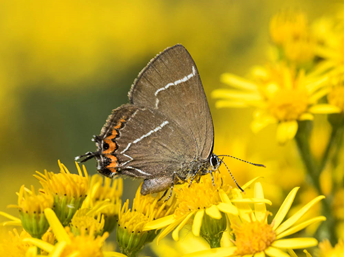
The Ragwort and Thistles have a lot of bees on them and there are other insects too such as the Soldier-Beetles, hoverflies including Eristalis species (with both E.pertinax and E.tenax), Sphaerophoria scripta, Helophilus sp and Marmalade Hoverfly to name the commoner ones and further up the hill there is a hoverfly with a black body and white “hook” marks, Scaeva pyrastri, a common summer fly and often migratory with influxes from the continent. By this stage as you can image I am feeling rather pleased I did not stick to my original plan which as mentioned earlier was to go to the Ham Lands over in Teddington.
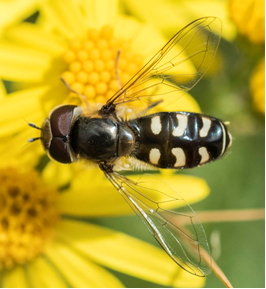
Amongst the other butterflies Small Skippers are prominent and there appear to be a lot of them. There is also a single Red Admiral, a single Peacock but no Commas are seen today. Meadow Browns are also common but on one Thistle there is a Gatekeeper, another first for the year! Marbled Whites are also pretty common in this spot with about six being seen and I spot a female being bothered by a male as she takes nectar but she makes it clear she is not interested in him and after a couple of minutes of wing flapping and flying around he goes away. Also seen on the Ragwort plants are the distinctive black and yellow caterpillars of the Cinnabar moth. I have not come across any of the black and red adults recently and had been told yesterday that the caterpillars were about. Some look quiet large but most are still small. Given the number of available plants a surprisingly low number appear to have the caterpillars on them but that may change over the next few weeks.
Walking up the hill towards Ham Cross I check out yet more patches of the yellow Ragwort by the road side where there are four male Fallow Deer grazing or lazing around. The plants yield very little that is new although there is a Bee-Wolf Wasp, Philanthus triangulum, which is just resting on the flower head.
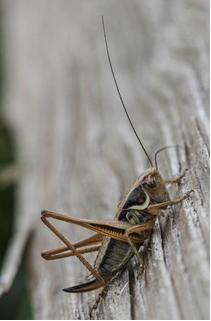
From here I go across towards Isabella Plantation but there is nothing much of note and so I head back towards the bridle path and Kingston Gate. There are several female Red Deer grazing and then there is some bird sounds I do not recognise (bird calls are not one of my strong points) so I look up and there are two Kestrels flying around. They soon disappear into some trees and looking at the Ragwort here there is one of the Bumble-Bee mimics, the hoverfly Merodon equestris. It really is a good Bumble-bee mimic and even as I photograph it I am not 100% sure if it is a hoverfly or a bee because I cannot seem to get a good view of the head to determine if there are long or short antennae but the photograph makes it clear what it is. After seeing this I proceed towards the wood-fenced area where there are normally a few Robber-flies. Today there are not a few Robber-flies resting on the fence, there are dozens of them, at least three dozen I would say. I take a few photographs and they all appear to be the Machimus type and are certainly not the Dioctria species which I have been seeing in and around Ham Common Woods for the past week or so. There are a few grasshoppers and bush-crickets a round, most are still not adult although one Bush Cricket which is resting on the wooden fence does appear to be an adult and to be Roesel’s Bush Cricket because it has a yellow-green edge to its protonum.
By now the cloud cover is blocking the sun, it is 13:00 hours and so I walk from here to Kingston Gate but see nothing of note on the way. Still what a fantastic morning walk. I am delighted with what I have seen and if only it was possible to make the right choice of place to go every day but of course it is not! The 7th July shall always be a White Letter (Hairstreak) Day…
July 8th – Basically a wet day with rain and drizzle throughout the morning but it stops in the early afternoon so I take a walk to Ham Gate. Not a good idea because the rain starts up again and there is nothing to do but shelter from the rain. After ten minutes or so it eases off so I wander up the hill checking the Ragwort and Thistle. Given the weather conditions I am not surprised to find only a few insects are active, there are Marmalade Hoverflies, bees and that is about it although I do see a Small Skipper which remains perfectly still on a Thistle flower and a Gatekeeper doing the same on Ragwort. After an hour or so it is time to head home and I only stop to talk to the woman who is supervising the cherry-picker truck that is checking out trees for the Oak Processionary Moth nests. She is surprised when I tell her about the White Letter Hairstreak but she tells me there is a mature Elm close to the spot where I saw the butterfly yesterday which is good to know and makes my sighting highly plausible, no Elm nearby and no butterfly! I go home and dry off…
July 9th is a wash out, wet, grey and with rain showers.
July 10th starts off a little cloudy but this soon clears leaving some blue sky although the clouds just keep coming. It is not a bad day, warm when the sun shines and cooler when the thick clouds cover the sun which they do with increasing frequency, still I start walking from Kingston to Ham Gate to check out the White Letter Hairstreak patch of Ragwort. Walking through the Park there are lots of flies, mainly ones that I am not interested in but there are a few hoverflies, M.florea, Syrphus ribesii, Melanostoma scalare, and Marmalade Hoverfly, and these are resting on the top of leaves, often waiting for the sun to shine. By the Large-headed Resin Bee site there are three of the Machimus type robber-flies and a Dioctria type perched on a Bracken frond. When I reach Ham Gate there is a surprise because there is no yellow patch, all of the Ragwort has literally gone so my assumption is the Park authorities had physically removed all the plants. My plan is scuppered although I do see a Small Copper and so I go to the alternative which is to visit the Ham Lands by Teddington Lock.
Checking the flowery patch just outside Ham Gate is a waste of time apart from a perched Volucella pelluscens because there is no sunshine hitting the spot yet and so it is a walk via the open area up to Ham Common itself. Crossing the main road I walk across to the pond where there are Mallard ducks with chicks and plenty of Jackdaws around, one is having a wash in the shallow water while two other perch on the trunk of a Willow tree. There is not much else to see so I head towards Teddington Lock following the cycle path signs. It is about a twenty minute walk from Ham Gate to the start of the Ham Lands, longer for me going because of the meandering, dawdling and time spent checking out various spots along the way but I check the time it takes on the way back. The Hogweed which had the Cheilosia and other insects a few days ago are no longer in flower and are going to seed. It makes me wonder if the same will be true when I get to the Ham Lands, the umbellifers and Knapweed there were good for insects on my last visit but will they be today?
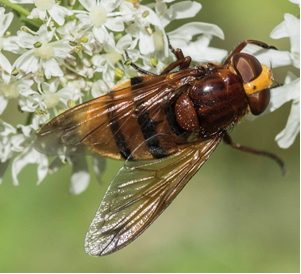
Before reaching the spots I am aiming for there is a patch of Hogweed by the asphalt path. There are many insects on it, a lot of Eristalis hoverflies, Syrphus sp and best of all there are couple of Volucella species, the hornet mimic V.zonaria, the largest hoverfly in the UK and V.pelluscens once again. There are also Tachinid flies, with black and yellow abdomens as well as a few beetles. I spend ten minutes or so taking photos before walking back along the path to enter the area of flowers amongst the trees I had visited last time. There are Knapweeds, umbellifers (not just Hogweed), Hop Trefoil, Bird’s Foot Trefoil, etc (all the same as last time) but with Tansy also coming into flower.
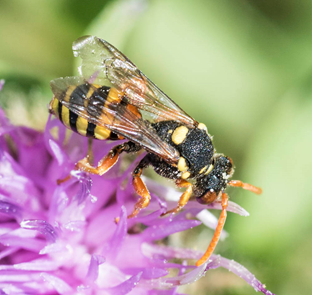
Butterflies are flying; Small Heath, Small Copper, Large Whites, Small Skippers and Meadow Browns and there are a few singletons too: Peacock, Green-veined White, Holly, Red Admiral and Ringlet. Amongst the flies there is the Tachinid fly Eriothrix rufomaculata, the one red patches on its hairy, black abdomen, a hoverfly Dasysyrphus albostriatus, more V.pelluscens and a Cheilosia species. Bees predominate and there are various Bumble, Carder and Honey bees but another Conopid fly appears and tries unsuccessfully to attack a passing bee. The same as last time there is a single Nomad Bee on the Knapweed and it has a bit of red on the abdomen so maybe a species ID is possible this time – it turns out to be a Painted Nomad Bee (Nomada fucata). Solitary wasps (all appear to be Cerceris rybyensis) are seen feeding on flowers and one Hogweed flower actually has four of them on it which is a surprise. The others appear as singletons on various other flowers such as Knapweed and a few other bees are photographed but their identification looks unlikely. Only a single spider is actually found, a small yellow crab-spider, Misumena vatia (with no red markings on this one).
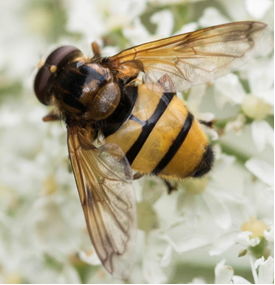
Leaving the area I recheck the Hogweed patch with the V.zonaria and there are much the same insects as earlier although one of the large hoverflies is photographed. It looks a bit smaller than the other individuals and with tergites 2 being yellow meaning it looks more like V.inanis than V.zonaria and I think the photos confirm that identification. Three Volucella species is good to see in one spot (but this is in my experience over the past few years is not uncommon). Still it is the first time I have seen all three together this year!
I decide to go into the bigger area of Ham Lands situated on the other side of the path and it all looks very promising with some of the same flowers but there are also patches of others such as Teasel which can be good for insects. Ten minutes is spent talking to a couple who are doing a butterfly transect which they do on a regular basis. A Marbled White flies by whilst talking to them and they tell me where I have been going wrong with Hairstreaks. What I should be doing is going out in the afternoon when the Hairstreaks tend to come down from the treetops to take nectar, a useful tip, but probably not one I will follow up on. They also tell me White Letter Hairstreaks can be found on the north side of the Ham Lands, another useful tip and that White Admirals can be found near Ham Gate, so something to look out for because this is a butterfly I have rarely seen in the UK, in fact I have probably seen more Southern White Admirals (stunning creatures from the underside) in Turkey!
After the couple move on I explore for a little longer before taking the 45 minute walk home (probably close to 3 miles I reckon). The clouds have come back so it is almost a little chilly although humid and there appears to be rain in the air, I feel a few drops, but there is no actual rain so I look at the umbellifers and other flowers, including a flowering Meliot (a member of the pea family). It looks promising but I only get a few more solitary wasps (Cerceris rybyensis once more) and a Rose Chafer which is always good to see.
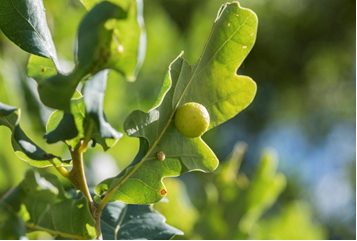
After that it is basically just the long walk home only stopping to check the Ham Common Woods open area. A quick check of the nest holes reveals nothing but a check of the trees reveal another gall, a green, cherry gall on an oak leaf, and this is like the other oak galls mentioned caused by a gall wasp, Cynips quercusfolii. These galls usually form in autumn and can be red, hence the name so this is an early one! I arrive home at about 14:30 after a couple of short stops on the way back but there is nothing seen to add to my daily sightings.
July 11th is another day with mainly fluffy white clouds and sunny spells. There is also a chilly wind and for the first hour or two it really does feel cold when there is cloud cover and the wind hits. My route today is the same as yesterday although I do not linger in the Park or Ham Common Woods but head straight for Ham Lands. I spend an hour less there than yesterday because the insects really do not seem as good and I also explore the Ham Lands further north but without much additional success other than a single male, Banded Agrion and one Sicus feeding on a Thistle.
The flowery area and the unbellifers have in the main the same insects as yesterday so I will not repeat what was recorded for yesterday although a nice surprise is to see several Ringlets, one even feeding on the same umbellifer as yesterday. A bright yellow male Brimstone floats by, several Holly Blues are seen flying around the trees and taking nectar from a Bramble flower and then there is a single, aggressive, small dark butterfly, brown with lots of orange that chases a Meadow Brown off a Knapweed flower. This is another first for the year, a Brown Argus, another blue (Lycaenid) as it happens despite being brown.
I take several bee photographs and the only hymenopteran to really take my eye is a largish solitary wasp on a low umbellifer flower. The abdomen is black and yellow and it has long antennae (18 segments according to the books) which are constantly moving over the flowers in front of the feeding mouth. Something at the back of my mind says ichneumon wasp and so it turns out, this being a male (yellow at the end of the abdomen) of the species Ichneumon xanthorius, so it is a true ichneumon wasp! All ichneumon wasps are parasitic and the host for this species is various moth and butterfly caterpillars.
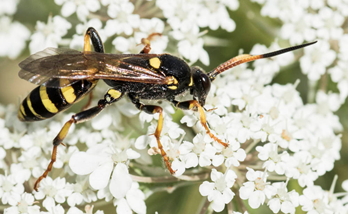
I am home about one thirty after what has not been a great day, I was hoping for a lot better.
July 12th – despite not really feeling like going out for a walk I do so about 11 and head for the Kings Charles Spinney area. The cloud cover comes and goes but it cools down quite a bit when it does. Talking with another photographer delays me for some time but the clouds cover the sun most of this long period and once I reach King Charles Spinney there is not a lot to see, other than another wasp nesting site just outside the gate with about twenty holes. I see a couple of Cerceris flying around and disappearing down their holes but that is it. Butterflies do not really show and there are only a few Speckled Woods flying around and a single male Brimstone. There are a few flies and bees but other than that nothing worth mentioning and this situation is now unlikely to improve as most of the Bramble flowers are over. A large spider shows in its web and appears to try to chase my lens away or maybe it can see a reflection of itself that it goes after. This proves to be Agelena labyrinthica the same species as I photographed a few months ago. The only good thing to see in this spot is my friend Shelly walking down the path and so we have a chat before parting company which improves my mood, today I am feeling a little flat, not sure why although the unsuspected cloudy sky certainly plays a part.
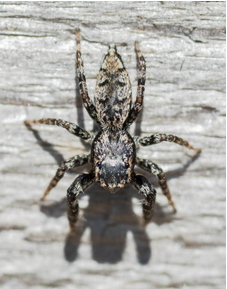
However heading back up the hill the sun starts to shine, the sky turns blue and it remains this way for the rest of the afternoon. A few minutes later I notice that there are flying ants around, lots of them. They are leaving their nests and clambering up grass stems before flying off. There are several of these nests and all have flying ants leaving, I guess the biggest ones are queens and the smaller ones are the males, drones, but I could be wrong. For some reason this sudden and unexpected burst of interest helps cheer me up so after a coffee from the Isabella Plantation shop (not directly outside the plantation but by the car-park up the hill!) I head down the hill and across to Isabella Plantation. On route there is a waste bin which has as a jumping spider (Marpissa type) on it and this spider makes some rather haphazard attempts to catch a flying ant that is within a few inches of it but fails with every feeble attempt. However the main feature of the short walk is the Bracken and how extensive and tall the swards of it are. All very green. From the still locked gate I walk along the path towards the Cerceris nesting site as it is sometime since my last visit. On route I take a look at the patches of Ragwort many of which have smatterings of the yellow and black Cinnabar caterpillars along with bees, Cerceris wasps, tachinid flies, various hoverflies including the bee-mimic Eristalis intracaria and other Eristalis species along with butterflies such as Small Copper, Gatekeeper, Meadow Brown, Small Heath and Ringlet. Nothing really new but a good haul of things.
Just around the corner is the Cerceris site and it appears to have extended a bit since my last visit although initially there are not many wasps around. I hang around in the warm sunshine and see a single H.niemelia investigating a hole. It tries to get into the hole but rapidly backs away before the occupant pushes up some soil to try to drive it away. It seems to work. Then a fat looking Cerceris appears and flies around the holes. It is carrying a weevil and lands before trying to drag the prey into a nest hole. The hole is not wide enough and the wasp drops its prey in order to scoop out some more soil before dragging the weevil into the hole. Several other wasps appear and they are also carrying prey. They have no difficulty landing and literally diving down a hole, prey and all. The majority seem to have the knack of doing this so photographing them is a matter of speed and luck. I get a few shots…
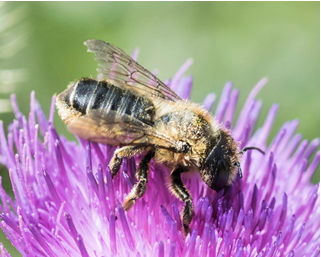
With nothing new appearing I move around to the other gate of the Plantation and check out the Ragwort in front of the gate. There is a young lady there with the bee book and a selection of small pots. She is catching bees and trying to identify them. We have a chat and I get an identification from her, she uses her eye glass to see if the “Megachile” bee has an arolium, a small structure, between the claws of the tarsi. If it does it is an Osmia and if not it is from the genus Megachile (as I suspect but have not been able to prove before). Her bee is a Megachile and she identifies it as a Patchwork Leafcutter Bee (M.centuncularis) which fits in with some preliminary ID work I have done previously but was not 100% sure of (sometimes I should trust my own conclusions!). The only other bee I note here is a similar looking Nomad bee (Nomada sp) to the one I saw on Ham Lands on 10th with a small red patch at the top of the abdomen. This one turns out to be Orange Horned Nomad Bee (Nomada fulvicornis), the fifth species of this genus for the year which is better than I have ever done for this group before.
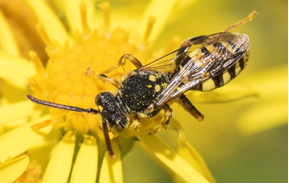
Slightly more bizarre is to see what appears to be a very strange insect with the front half of a hoverfly and the rear of something like a sawfly, with a pointed bit at the end. Although not clear at the time from the photographs it would appear this is actually a hoverfly, Eristalis pertinax to be exact, which has not fully emerged from its pupa case but is flying around with it still attached. Never seen anything quite like it before and you would have thought the case would impede the hoverfly from moving but no it flies well because its wings are clear of the casing. A very strange sight.
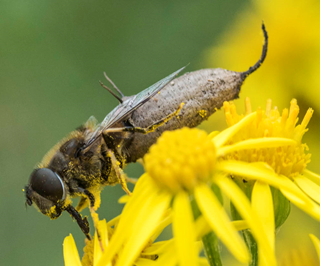
There are also a pair of mating Small Coppers which refuse to stay still so no good photographs and better still is number of fresh looking Peacocks, at least half a dozen are on the Ragwort and Thistles. A lovely sight and I am happy to see so many and then the young lady says she saw thirty earlier in the day at another spot! How special is that? In retaliation I make her jealous with my White Letter Hairstreak… I leave her to head home round about 15:30. What I initially thought was going to be a dull day with little interest has proved to actually be a rather good one!
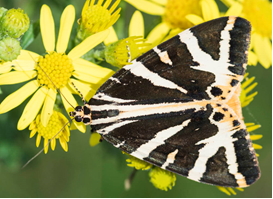
July 13th is another warm day, up to 24 or 25C according to the BBC weather forecast. I go into Kingston to use Kristal once more (loading up June’s images onto the website) and as it remains warm and bright I decide to head along the River via Canbury Gardens towards Teddington Lock and to come back via Ham Lands and Ham Common Woods. There are a few Peacocks, a Large White and Red Admiral on a flowering buddleia bush and a few Bumble Bees too. Walking along the River the Hemp-Agrimony is flowering but with only a few things on it, bees mainly so I photograph a few and one turns out to be a nicely banded Colletes species. Commas make an appearance but so does something a bit different, a large day flying moth, a Jersey Tiger (Euplagia quadripunctaria) in fact. It is this that makes me decide to continue and to take the long route home rather than turning around at this point before heading back via Kingston. A moment later I see a turtle in the river resting on a log, typical turtle behaviour but I do not expect to see one in the River Thames although later a guy tells me they also inhabit some of the ponds on Wimbledon Common. These animals really should not be here and this one is about 9 inches long so has been in the river system for some time I suspect. No doubt it was a pet that has been “released” into the wild…
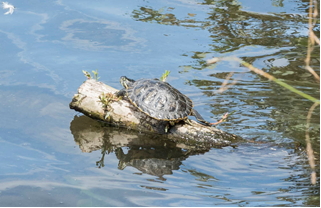
Heading up to Teddington Lock does not yield much but I am hoping that Ham Lands will. It does not work out that way partly because the umbellifers which were so good a few days ago are almost over and have only a few insects on them now. Even the Knapweeds seem to have slim pickings with mainly bees, unsurprisingly Honey and Bumble once more, on them. It is getting hot and as this is an impromptu walk I have no water with me so decide to cut short my time in the area.
I head back across Ham Common and then cross the road into the Woods. What a good move as it happens. The main shaded path heads towards Ham Gate along the side of the road but there is also a narrow path that goes to the right between some thick Brambles. The other day the Oak Processionary woman mentioned that the Purple Hairstreaks sometimes come down from the tree tops to mud-puddle and today I see exactly what she means. The soil does not appear to be very wet or muddy but must have had some nutrients in it because there was not one, or two, or even three Purple Hairstreaks but up to four on the path with proboscis extended and at least a couple more flying around and landing on the Brambles. Another wow moment for sure. I take a few photographs of the Hairstreaks, hoping one might be another White Letter but no such luck while ignoring the Meadow Browns and Speckled Woods that are also around the same spot.
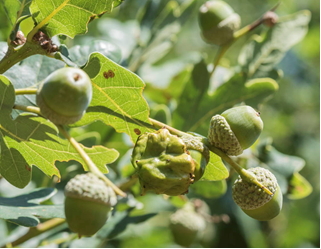
Heading towards Ham Gate via the open area there are lots of the Hymenoptera nest holes are still open and several have fresh piles of soil around them but apart from a couple of wasps, one with prey that disappears straight into a hole, there is very little activity. Looking at the Oak trees I take a few photos of an artichoke gall and also notice how the acorns are becoming well-developed, small but still formed. Several are already showing the typical wrinkled form of a Knopper Gall (caused by yet another gall wasp, this time Andricus quercuscalicis), I am doing a decent job ticking off the common galls of Oak this year. After this I basically head straight for home arriving about 14:00 hours. It feels good to cool off once home but the sun continues to shine through the white clouds during the rest of the afternoon and so it feels warm too!
July 14th – after loading up some photos and chatting to Kara outside the Albert I go for a short walk into Richmond Park but the weather isn’t great, it is rather overcast and threatens rain, that does not come so I go home and spend most of the afternoon writing rather than looking at photographs, I need a change once in a while!
July 15th – as the weather is not great I decide to go back to see Mum, my first visit in four months. It feels strange to be on a tube, the trains are okay but the number of people not wearing masks or with their noses not being covered is a little disconcerting especially as most of these law breakers are of BAME origins, and are women. In Mum’s garden, just north of London in Cheshunt, she sees an orange butterfly only it turns out to be a moth, a second Jersey Tiger of the month! That is the only natural history of the day worth recording…
July 16th the day starts off cloudy and does not look very promising although in the early afternoon it brightens up. I take a walk via Ladderstile Gate and visit the wooden fenced area first. Nothing new just the Robber and other flies so I check out some of the nest holes in the path. There are some Cerceris wasps around (C.rybyensis) but several of the holes appear to have been taken over by ants and when a wasp tries to go into one of these holes it exits rapidly with ants chasing after it.
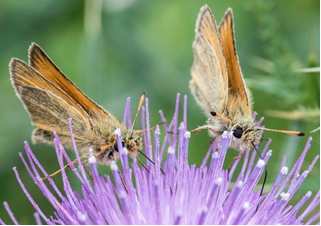
A walk across the Park then takes me to the Ragwort and Thistle patch and whilst I am looking at the fresh Small Coppers and Peacocks on the flowers, as well as bees and other things like Essex Skipper (with black undersides to the antennae, Small Skippers always appear earlier than this species), a loud banging of the metal gate alerts me to the fact that Isabella Plantation has actually re-opened! I was expecting it to be next week but apparently it opened on Tuesday. Hooray about time… Before I leave this spot and go into the Plantation I see a Holly Blue and a couple of Megachile type bees, one large and one small.
Once inside the Plantation it is clear that Peg Pond has a lot of uncut growth surrounding the open water, the reeds are tall and the Hemp-Agrimony is coming into flower. Willowherb and Purple Loosestrife are flowering and there are many Bumble and Honey bees using them but not much else other than Tachina fera (a large fly with a shiny, dark yellow abdomen with a black central line). This is a common fly and also uses Ragwort on which to feed. The Plantation does not yield many good insects but there is not a lot of sunshine so maybe tomorrow when the temperature is going to be a bit higher will prove to be better. Going out the Bloomfield Hill gate and checking on the same Ragwort as the other day there are the same insects as mentioned then although a Peacock poses nicely, a Red Admiral shows itself well, there is a tatty looking Ringlet and a single hind wing from a Purple Hairstreak. A Green Veined White appears (and a second one is seen in the front garden when I get home) along with a Bee-Killer Wasp which unsuccessfully attacks several bumble bees, it just seems to bounce off them. A Cerceris wasp is also seen and there are lots of Cinnabar caterpillars on the Ragwort.
Checking out the Cerceris nest site yields several wasps bringing weevils back to their nest holes. As before one struggles to get the prey into a hole and has to dig it out but the others just disappear straight in without any problem. There are three Jewel Wasps seen and then what looks like a small Cerceris but may well turn out to be a Nomad Bee, it has that jizz to it. I photograph this insect so I hope to get a good identification from the resulting photo but although the photo confirms it is a Nomada, a species identification is not possible at present. There are also some small flies which like the Jewel Wasps are investigating the nest holes. I think that might be parasitic ones too.
It is then time to go home so that is what I do.
July 17th – A warm and often sunny day but cooler when the clouds cover the sun which they do for twenty or thirty minutes at a time. I spend a lot of time talking to other photographers and naturalists so it is an interesting day especially as one of the people is leading a group and appears to be the Butterfly Conservation person who covers Richmond Park. He takes note of my White Letter Hairstreak sighting which is apparently so far this year the one and only reported sighting of this species! A great feeling… Anyway back to today and I come through Kingston Gate and walk across to Ham Gate before heading up towards Ham Cross and Isabella Plantation.
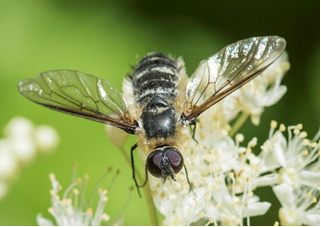
I see a few things on route but there is not much new although a Robber-fly with a large Sacrophaga fly as a prey item is good, so I go into the Plantation once again noticing how overgrown the vegetation, especially the reeds, surrounding Peg Pond is. I have heard Reed (or maybe Sedge) Warblers in the reeds in previous months but there is no sign of them today nor of the Water Rail that also lives there, or so someone told me. On some Meadowsweet by the side of Peg Pond there is a largish black and white fly which initially I think is a hoverfly but it has six abdomen tergites rather than three or four that hoverflies have. It proves to be a type of bee-fly (Bombyliidae) and is a Villa species, recorded from Bushy Park but I can find no references to them being in Richmond Park. Then there is a Purple Hairstreak on the ground. In fact there are several more during the morning and afternoon so it is a good Hairstreak day. Actually there are lots of butterflies around on the flowering plants. Peacocks are very common today and so are Gatekeepers and Meadow Browns. One guy is looking specifically for Small Coppers and I do not know if he was successful but I see none and in fact I only come across one Lycaenid, a Holly Blue.
There are several other insects, mainly hoverflies including a Xylota sylvarum that keeps coming back to the same spot and various Eristalis species but no Volucella which I often see on the Hemp-Agrimony and there is a green Soldier-fly Chloromyia formosa in the same spot as the Xylota. There are of course many bees, the same ones the previous days in the main but they get photographed any way and there is also a bee, mainly black with a red abdomen (a blood bee I think, possibly even if the behaviour is not right) perched on a wooden fence on the edge of Peg Pond. And just for completeness, one Conopid fly is seen on Meadowsweet.
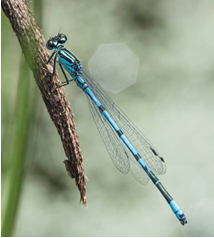
During the middle of the day it is cloudy so that is when I talk to others. We have some interesting conversations including one about Raja Ampat where I had been last year. There is not much else to report on until I go around to Thomson pond where there are several damsel and dragonflies including a female Brown Hawker ovi-positing, an Emperor female ovi-positing and several Darters, which are the red males, Ruddy Darters, with black legs that had no yellow on them (the Common Darter has yellow in the legs). The main damselflies are Azure Damselfly and the widespread blue tailed Ischnura elegans, although there may be others present, I do not see them.
One intriguing hoverfly is another good bee mimic and it does not have just black legs so is not a Merodon equestris, one to look up. It appears to be Eristalis intricaria although I am hoping, in vain, that it is something different! There are also a couple of the Dioctra type Robber-flies one perched on a fence and the other on a leaf.
Birds are not showing well today for example on Peg Pond there are only a few ducks (Tufted and Mallard) and Moorhens. A Grey Heron is heard and seen on the same pond and on Thomson Pond there are Tufted Ducks with ducklings but not too much else although during the day some aerial mewing, probably from Buzzards although Sparrowhawks nest in the Plantation, is heard. Small birds are noticeable by their absence and there have been a lot more people in the Plantation today than there was yesterday which may has frightened them off.
July 18th starts cloudy but clears up to be hot and warm by the early afternoon and so after yesterday’s successful exploits in Isabella Plantation I thought I would repeat the experience. Much of what is seen today is the same as yesterday so only new things or the ones I consider of interest will be added to this write up. So starting with the Odonata for a change, the advantage of having ponds around, the best sighting is of a perching Willow Emerald (Lestes viridis), a damselfly which is a first for me in the Park although I have seen one this year in Ham Common Woods. The female Brown Hawker is not egg laying and nor is the Emperor so there are only the males of these species flying over Thomson Pond but a female Brown Hawker is spotted egg laying in Peg Pond. There are a lot of Damselflies around and Common Blue Damselflies are egg-laying with the male appearing to dunk the female’s head into the water as well as her abdomen. There are also several Blue-tailed Damselflies (Ischnura elegans) including a female with a red rather than green thorax. You can also get purple females in this species but they are less common than the green ones. The male Ruddy Darter is still around the Bog Garden but that is all I can report for this insect group.
The robber and hoverflies are much the same as yesterday although I do get to see another mating pair of Machimus Robber-flies. They are on the leaf of a bush and there are also several Dioctria types around as well. Hoverflies are the same again although a notable exception is finding Xylota segnis on a grass stem which allows me to take a few shots and there is also Helophilus pendulus (photo confirms). There are other flies around too, lots of Tachina fera but nothing really nice or different. I photograph several bees on various flowers so some IDs may be to come but we shall see. The “blood bee” I saw yesterday is in exactly the same spot and on reviewing the photographs and thinking about its behaviour I am beginning to think this might be a Sawfly, I did see one for sure in the Bog Garden area and although slightly different it got me thinking about this one too. Something more to work on, along with the Robber-flies and Hymenoptera… One interesting find is a social wasp which lands on the edge of the pond and appears to be drinking so I take a quick photograph which shows some red patches on the front of the abdomen indicating this is a Norwegian Wasp (Dolichovespula norvegica).
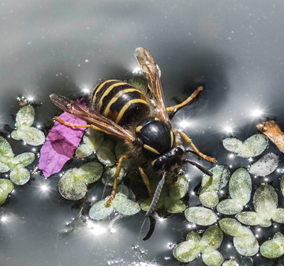
Purple Hairstreaks are common, mainly mud-puddling on the paths close to the ponds. Once you get your eye in they seem to be every where and I have to ask myself how I missed them in previous years. Lack of knowledge and no “search pattern” are my only excuses. The butterfly numbers seem lower than yesterday but that is probably because I am confining myself to the Plantation (although a single Small Copper is noted on the way home). Much the same species as well although with a Holly Blue seen near Peg Pond along with a Green-Veined White.
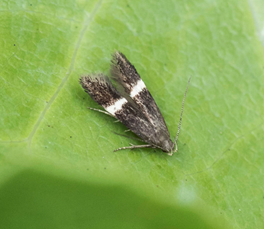
One dark micro-moth with thick white bands fools me into thinking it is a fly because it flies up and down back onto the same leaf before running around the leaf. Strange moth behaviour and a possible ID is Microthrix similella, which like mature oakwoods and parkland with large oaks although a Stigmella species is more likely.
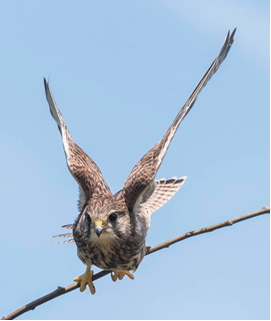
This is really a photography day with the fluffy, cute Tufted Duck ducklings on Thomson Pond being the main attraction there for many photographers and there are a couple of Moorhens with single chicks too. No other birds are noted from the Plantation but just outside three Kestrel fledglings are hunting or so a fellow photographer tells me. When I leave the Plantation one is still around and so I get a few shots of it perched in a tree before it takes off. It dives close to my feet, less than two metres away for sure because my long lens will not focus closer than that! After a few seconds the Kestrel flies off, it probably has had a lot of attention from photographers today and wants a break from the limelight…
Home at 2:30 after an interesting five or so hours in the field. A good session.
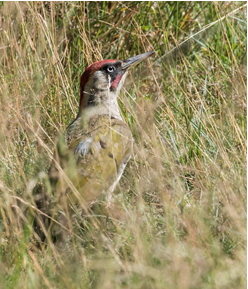
July 20th after a chilly night there is a bright blue sky with some fluffy white clouds so after a coffee in the re-opened Albert (the station coffee shop is still closed) I go back to Isabella Plantation expecting to see some new insects. On route I notice that several of the Oaks in the Park have acorns and more than one has Knopper galls developing. They are still all green at present but darken up and often turn reddish with age. There are also two pairs of Green Woodpeckers on ant-hills and in one photograph ants can be seen on the beak of the bird. These are the best and closest views I have had of this bird in the Park and certainly the best photographs and they are certainly the only “keepers” I have had!
Isabella Plantation is quieter than Saturday but there are not a lot of new insects around although Volucella pelluscens shows up along with a few other things I have seen previously. Perhaps the saddest sight is to see the remains of a Purple Hairstreak in a spider’s web. Still some photographs of various insects get taken and whilst walking around a flying female Mandarin duck goes straight into a hole in a tree. It must be a nest because these birds nest in trees. It is the first one I have ever found (although to be honest I have never looked very hard for them).
It is getting warm and close to lunch time so I go to the Albert where a pint has my name on it. I arrive about 1PM for my first pint of Peroni in almost exactly four months. Socialising today takes priority over natural history!
July 21st. Yet another nice sunny day with blue skies and hot sunshine although when the white clouds go across the sun it cools down somewhat. A walk to see if I can get some more shots of the Green Woodpeckers proves fruitless but there are several Robber-flies on wooden fences including another mating pair and several feeding with small insects in their jaws, so I head across to Penn Ponds and see a young Kestrel close to the nesting tree. On Penn Ponds there are several Common Terns, one fishing whilst two others seem more intent on out-flying each other rather than fishing. The fishing bird comes close but the cloud lowers the light levels quite drastically and so the shots do not come out very well. It then poses on the inlet device in the larger pond which is close to the causeway with about half a dozen Black-Headed Gulls. Out on the water a couple of Great Crested Grebes cruise backwards and forwards followed by a Cormorant while above the Swallows zoom around. There are also a couple of ducks, some Canada Geese chased in the water by a dog that is not on a lead, Mallard with three chicks, Coots and a Moorhen as well as the resident Mute Swans, the cob lays on the causeway and looks dead but is only resting although it refuses to move for anyone!
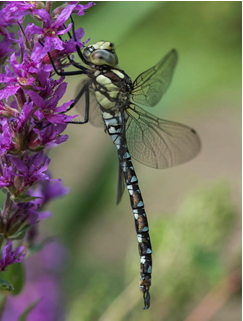
Moving on I go to Isabella Plantation and it is pretty hot, my forearms do not normally really feel the heat but they do today especially when holding the long lens. There are not many new insects but there are several nice ones and so I take photographs of Purple Hairstreaks, some flies (one is Snipe-Fly like – Thereva nobilitata once more), a Bee-killer Wasp, Eristalis intricaria, Volucella zonaria and something new, an immature Southern Hawker male which is resting on Purple-Loosestrife flower-head. Butterflies although in large numbers are all the same as yesterday but three Brimstones are also seen, two females and one smaller and brighter yellow male. Small Coppers are seen on the way home on Ragwort although not in the Plantation itself. There are a few of the common hoverflies, a Marmalade or two, Helophilus and Myathorpa florea on the various flowers and even a Conopid fly (Sicus yet again!) feeding on the white, sputnik like white flowers of a bush in the Plantation.
Next time I think I need to take my tripod to photograph some of the plants now coming into flower, Creeping Jenny and Mint. The Ragwort does not seem to so productive anymore, many of these flowers are dying back and the land is very dry so maybe they are not producing much nectar. Brambles are now in fruit with most of the flowering being over. One or two of the blackberries have been picked and eaten although the vast majority are still green!
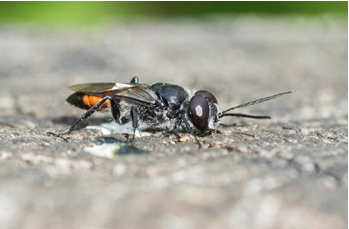
A pleasant day in the field, I am out for five hours but not necessarily great in terms of new species although maybe some of the photographs will turn out to be decent ones. An evening in the pub and on their internet allows me to check a few websites including that of Jeremy Early, a very good site with lots of invertebrate images on it and from this I finally get an identification of the black long-horn beetle I first saw on the 9th June. It is, as added to the text, a nationally scarce beetle, a Black Longhorn Beetle (Stictoleptura scutellata) so a good find after all! I also use the site to check on the Blood-Bee/Sawfly/Spider-hunting Wasp/Ichneumon Wasp that I have seen for three days running in Richmond Park on the same fence post on the edge of Pegs Pond and also on another fence in the Park. It leaves me more confused than ever and I still have absolutely no idea what this insect is other than it being a Hymenopteran… However later research implies it might well be a male wasp, Astata boops.
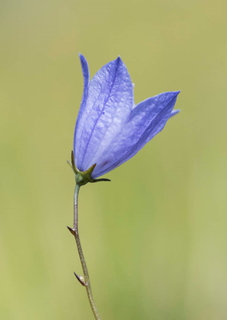
July 22nd Well I guess the end of social isolation has now arrived and so my trip today is to Box Hill, a two or three train journey depending on the connections, and taking between an hour and an hour and half again depending on the connections. Still disappointed by the number of those not wearing face coverings, including station staff at Raynes Park and I am pleasantly surprised to see a Policeman on the last train who is dealing with such passengers. Box Hill is renowned for its orchids but it is too late in the season and only three Pyramidal Orchids are still in flower. There is not even any sign of the others orchids which are usually abundant earlier in the year. Other plants that are in flower include; Ragwort, Fennel, some white umbellifers, Marjoram, a few Knapweeds, Hawkweeds, Scabious, Yellow-wort and Thistles as well as the other chalk land specialists such as Dwarf thistle, Centuarys, Milkwort, Clustered Bellflowers and a few Harebells which shimmer in the light breeze. One plant that is not in flower but in fruit is Cuckoo Pint with its red berries being highly prominent in the hedgerows and undergrowth.
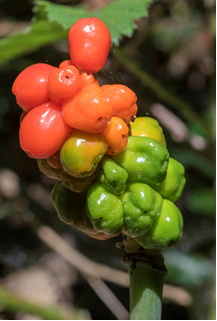
Insects are flying but there are mainly bees, some intriguing flies and butterflies which are the reason I have decided to visit Box Hill now that the orchids have gone. The regularly seen butterflies are present, so there is Red Admiral, Meadow Brown, Gatekeeper, Brimstones, Small Copper, Common Blue and Marbled Whites which until a couple of years ago I associated incorrectly with chalk downland, they are certainly much more widespread than that! There are a few Thymelicus skippers around but I do not get to see the underside of any antennae so they remain un-speciated. Dark Green Fritillaries are found in the Zig Zag Hill dip along with a single Silver Spotted Skipper (apparently they are late emerging this year whereas most of the other species are emerging two weeks earlier than normal) and a single Brown Argus. The commonest butterfly is actually the Chalk Hill Blue and there are plenty of the light, milky blue males in almost constant motion just above the vegetation. There are fewer females around but they are also present. The only species missing from my list and which is flying today I am told by a butterfly transect walker is Small Blue (but he does not have the Silver Spotted Skipper on his list). He confirms my other sightings which is useful!
Not the most productive of days because there really does not seem to be many insects around, the only beetle being, you guessed it, Strangalia maculata once more and how could I forget to mention another Conopid fly (yes Sicus again). One other insect to note is a black and red burnet moth that flew passed at one point but unfortunately it did not land so I cannot speciate it! The most interesting find is a bee-fly similar to the one I have seen in Richmond Park so is a Villa species (and Downland Villa would fit perfectly!). Still it is a day out and feels good to be away from the local areas for a change.
23rd July starts cloudy with a slight chill in the air but soon turns warmer when the sunny spells come along. I decide to revisit Isabella Plantation once more as I am sure it should be yielding more insects than it is, for example the Hemp-Agrimony some years is smothered in Volucella hoverflies but so far this year they are noticeable by their lack of numbers in the Plantation. Walking up from Kingston Gate I see two horses walking through the Bracken. They are attached to a roller/ crusher that flattens the Bracken and creates areas with reduced Bracken cover. There is a man driving them so it is an old fashion method of Bracken control and one that is no doubt effective if it is still being used.
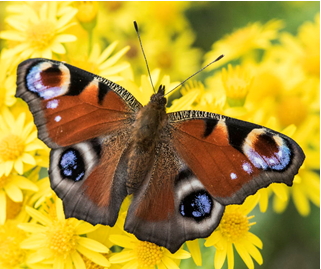
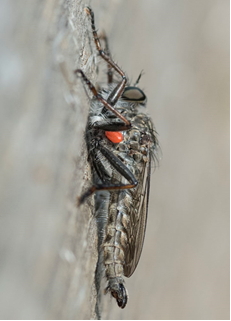
Gatekeepers, Meadow Browns, Peacocks, and are the commonest butterflies although several more Purple Hairstreaks are also around. However today is not the day of new things and I only see insects I have seen recently and spend some time photographing them before heading home. The only hoverfly of real note is Xanthogramma pedissequum and there is one Machimus robber-fly seen with a single red mite attached to it. I often see these red mites on butterflies (although not locally) but this is the first time I have seen one on a fly. Not a very productive insect day but I got some shots of Creeping Jenny and lots more Robber-fly shots…
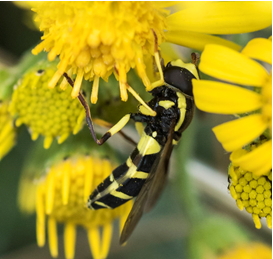
July 26th. After a cloudy start the clouds disperse and the sun shines although it is windy and there are rain showers including one at lunch time when I am in Isabella Plantation. I go through Ladderstile Gate and reach Isabella Plantation by a more circular route than normal seeing a herd of ten Fallow Deer on route. There are a few insect around mainly on the Ragwort, Gatekeepers and Small Coppers are the commonest butterflies but there is nothing new noticed on the fly front. The wooden fence with lots of Machimus robber-flies still has lots of them on it along with one or two Tabanus bromius horse-flies but not much else apart from some grasshoppers. On route a young Kestrel is flushed from the bracken as I walk across to the Plantation but there is nothing else of note.
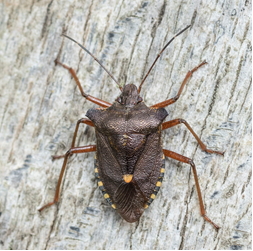
A walk around Peg Pond yields the usual suspects and the numbers of insects on the flowering plants is still disappointing but given the changeable weather conditions not that surprising. There are a few hoverflies around; a single Volucella zonaria, a hovering Xanthogramma pedissequum which for once was at chest rather than knee height, hovering Eristalis intricaria, Eristalis pertinax, Eristalis nemorum as well as some Syrphus and other smaller species including Syritta pipiens feeding on Mint (Mentha sp), the first of this species I have noticed for some time. There are less Peacocks around but the number of Gatekeepers seems higher and for the first time in ages there is no sign of any Purple Hairstreaks. Singletons of various groups appear and there is a rather nicely marked Shield Bug on a wooden fence that does not seem to want to move which proves to be a Forest Bug (Pentatoma rufipes). There are several flies which are small and black so I do not bother to photograph them and guess what? There is another Sicus by Peg Pond and a second one by the Bog Garden. There are few Hymenoptera other than the Honey and Bumble Bees and several ichneumons, a small one and a large one, Pimpla looking and much like the one seen on 11th June but this one refuses to pose for photographs and quickly disappears into the undergrowth. Apart from that there are some Hornets seen stalking unsuccessfully amongst the flowers and their large size really makes them stand out.
Walking back yields nothing exciting although close to the road and near to Ladderstile Gate a couple of large Red Deer stags appear and so having started the day with Fallow Deer it ends with the Red!
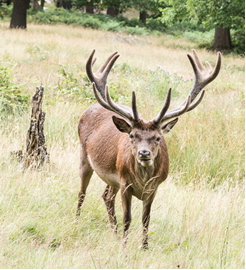
The next few days are a wash out. The weather means I stay indoors for most of the day rather than going into the Park or anywhere else.
28th July starts with clouds and sunny spells so I go back to the Park and head from Kingston Gate towards Ham Gate taking a few shots of the Machimus Robber-flies which seem particularly common now. Many are sitting on wood, logs, fences or railings and have prey items which they are eating. Usually the prey items are small insects but in the last week these seem to be getting larger, one being a Flesh-Fly the other day and today two of the Robber-flies have medium size hoverflies as prey. There are also some Tabanus horse-flies and checking their eyes they prove to be T.bromius once more. The windy conditions appear to put the butterflies off and there are not many seen today although a couple of Red Admirals are feeding on flowers. I hear several Green Woodpeckers and one flies into a tree but unfortunately none are close enough to be photographed.
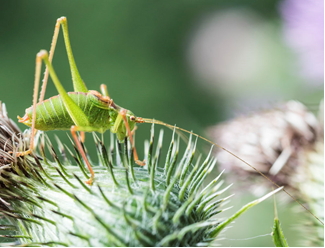
I take a detour and visit the flower patch just outside Ham Gate. There are a lot of Thistles in flower but with little on them although at this point it is a little chilly with the sun being hidden by the cloud. However there is a nice looking Speckled Bush-cricket on a low Thistle along with a single Cluster Fly (golden hairs on the abdomen) but the blustering wind makes photography difficult so I go back into the Park and check put the wooden fencing by Ham Pond and the Alders that are by the fence. A small yellow fruit fly is seen on the Alder along with several black “caterpillars”. These larva are associated with eaten patches of leaf and I have no hesitation in calling them Alder Sawfly larva.
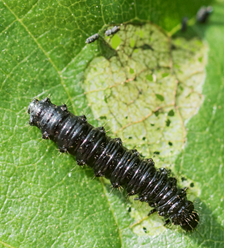
They fit perfectly with what I know about such insects but of course I am wrong because these turn out to be a beetle larva, the larvae of Alder Leaf Beetle! On the fence there is nothing special and several social wasps are scraping off wood for their nests but low down on a fence protecting a young tree there is a rather interesting fly so despite the poor light I take several photographs of what I am sure is a golden looking hoverfly, at least that is my first thoughts on its identification and that proves to be correct. This turns out to be a Bronze Sap Hoverfly, Ferdinandea cuprea. There is not much more around so I head up the hill to Ham Cross and beyond.
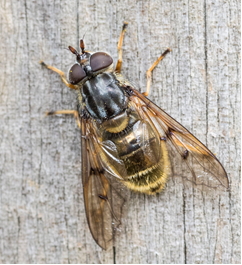
– Ferdinandea cuprea
Reaching Isabella Plantation I am a bit disappointed to see that the big Ragwort patch outside the gate has been physically removed just like the patch by Ham Gate the other week. They have left the Thistles and so there are bees visiting these flowers along with swarms of various size grasshoppers on the ground which scatter as I walk through the Thistles. Entering the Plantation the cloud thickens and although it clears to let the sun through once in a while the conditions are not ideal for photography or insects. Nonetheless I spend some time (two hours or so) wandering around Peg Pond and the Bog Garden area and take more than a few hundred photographs although with a low rate of success (i.e. hundreds of deletions…).
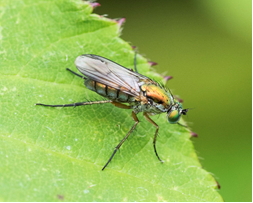
Starting with Ischnura elegans I find females with both red and purple thoraxes, one of each as well as the normal green thorax ones. I do not really notice any more Odontata. It is mainly flies after that, Tachina fera is common, and there are a few hoverflies; Marmalade, Eristalis pertinax, Sphaerophoria sp, Helophilus sp, Volucella pelluscens, V.inanis, a Cheilosia species with hairy eyes and a gingery hairs and the first Rhinga species for quiet some time as well as a single Meliscaeva auricollis. One addition to the species seen is another metallic looking fly Sciapus platypterus which is in the same family as the previously mentioned Poecilobothrus. Hymenoptera seen include several bees, a group of small orange bodies Sawflies, Bee-Killer Wasp and a small Ichneumon wasp. One good find is a large colourful but hairy caterpillar on a wooden fence which proves to be a Buff Tip caterpillar.
At about 12:45 the cloud looks to have thickened and it is a bit, just a tad, chilly so I head home and of course it is then the cloud starts to break and the sun starts to shine once more…
29th July starts out sunny and the forecast is for cloud to build up in the afternoon only the afternoon seems to start about 10:30! However by about 12:00 the clouds part and it gets sunny once more and rather warm. On entering Kingston Gate I get my camera out and as I am doing so what looks like a black Bumble Bee flies low but goes yellow when it turns. It takes a few seconds to sink in before I realise what I am looking at is a flying Rose Chafer. A good start to my walk and it gets even better about ten minutes later when a Red Fox appears resting on the Park wall. It stays put whilst I get the long lens out although when the first cyclist bombs through the Fox looks a little nervous and then it disappeared once a second cyclist zoomed past… My thoughts about the reckless, speeding cyclists (only 10 mph on the footpath around the edge of the Park…) are not pleasant ones.
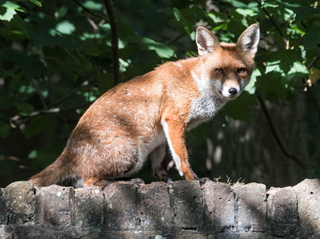
At Ham Gate there is nothing new and no sign of the Bronze Sap Hoverfly today so I walk up the hill to Ham Cross before going along the road towards Penn Ponds. By the big plantation three Kestrels are seen flying and hovering so I take a few(!) photos before continuing to Penn Ponds. The edge of the Plantation is good for small birds and there is a small family of Whitethroats in the low vegetation while lots of Blue Tits take the higher branches. Having spent a few minutes here I move onto the Ponds proper. The birds seen are much the same as my last visit although I do manage to get some well under-exposed shots of flying Sand Martins but there is no sign of the Common Terns although I am told one is still around. A few damsel and dragonflies are seen and a Broad Bodied Chaser is photographed before I head back towards Slade Ponds and the Kestrels.
Here I meet another photographer who is chasing around after the hovering Kestrels but I choose the “stay put and wait for the birds to come to me approach”. It would be interesting to know which is the more successful method! This is when the cloud starts to build up and it cools down a little.
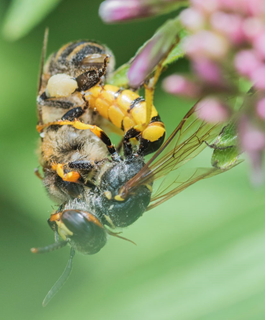
I therefore cross the road and go to Isabella Plantation. After hanging around for a few minutes the sun comes out again so I wander around Peg Pond where the Hemp-Agrimony is now in full flower and full of insects most of which are flies, Eristalis sp and the large, black and yellow Tachina fera but one nice find is the hairy eyed Syrphus torvus which I have not seen for a while. Also seen is a small black hoverfly which appears to be one of the difficult Pipiza group although it has yellow tarsi so may well be P.austriaca. Bees are around in large numbers along with Cerceris wasps and also the most Bee-Killer Wasps I have seen in a single day this year, at least half a dozen. One Bee-Killer Wasp is attacking and stinging a Honey Bee, their preferred prey item in which the egg is laid and the young develop. They are another Cuckoo Wasp/ clepto-parasite which lay eggs in still live prey. These are not the only these insects around but there are a lot more dragonflies flying around and a single black legged Dioctria hoverfly sits on a leaf and allows a close approach. .
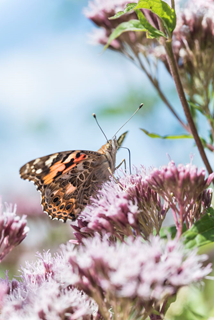
Gatekeepers are common and on one small, isolated Ragwort cluster there are ten of them! Meadow Browns are still around although Peacocks are only seen in low numbers, maybe only two or three. Purple Hairstreaks are mud-puddling and flying around Thomson Pond and a single tatty Holly Blue alights on Purple Loose-strife to feed. A couple of Red Admirals feed on the Hemp-Agrimony but they are not the only big butterflies around because there is also a really beautiful, fresh looking, Painted Lady, the first of the year for me and then something bigger than the rest flies through. I thought I had startled a Silver-washed Fritillary in the Park a couple of months ago and now I do actually see and photograph one! Wonderful and I get to show a young girl photographer both this and the Painted Lady. She was happy to see them too.
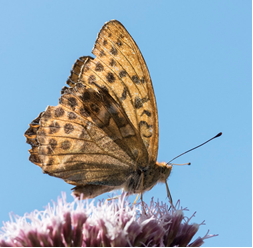
I head off home about 14:30 as I have no food with me and the clouds have gathered once more. What a brilliant day and for a variety of reasons.
30th July starts with a clear blue sky and remains sunny all the time even when a little cloud builds up. It is however 27C (approx) so a sudden jump in temperature. My route today is the same as yesterday but there is no fox, the Kestrels remain distant and there are no Silver-Washed Fritillaries or Painted Ladies either. Due to the heat I leave for home about 13:00 a bit disappointed as I thought the heat would have meant more insects. It seems strange but the numbers of most things seem down on yesterday with the exception of the Gatekeepers and there are a number of Purple Hairstreaks but the biggest difference is the number of Bee-Wolf on the Hemp-Agrimony around Peg Pond, there are between six and a dozen for sure rather than the one or two I have been seeing over the past few days.
31st July starts with a bright blue sky and is warm with the temperature getting up to 37C by 14:00. By the time I walk from Kingston Gate to Isabella Plantation the sweat is dripping off me and it feels too hot already at 10:00. Although the sun shines there is a bit of a warm breeze, enough to cool you off a little but annoying when trying to photograph insects on flowers.
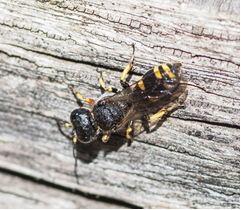
The insect numbers in the Plantation are down from yesterday, maybe it is too hot even for the butterflies although Tachina fera seems unaffected and so do the Bee Wolf and other solitary wasps, the few insect groups that seem to have maintained their numbers. I finally manage to get a decent shoot of a solitary wasp that is nesting in a hole on the wooden fencing around the edge of Peg Pond. It is another black and yellow species with a shiny abdomen unlike the punctuated and non-smooth surface of the common Cerceris species which proves to be another species of Digger Wasp, an Ectemnius species as I had previously expected but could not prove.
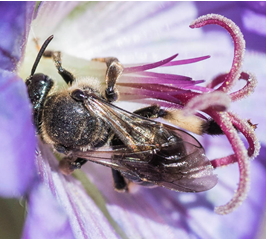
There are few bees around other than Honey and Bumble Bees and one subjective ID is of a female Little Yellow-faced Bee (Hylaeus pictopes), a small mainly black bee with small yellow marks on its face. A better photograph of a male is required and an August shot of a male implies this is actually a Common Yellow-faced Bee (H.communis rather than H.pictopes). On the same patch of Geranium there is another bee with distinctive rear legs that have a large white patch and this turns out to be Macropis europaea, the Yellow Loosestrife Bee .
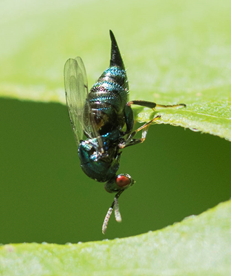
Once more a large ichneumon wasp evades my lens and there are a few Hornets flying in and around the flowers and vegetation no doubt looking for food items but none of them seem to attack any other insects and simply just fly through. Later on a leaf a small blue insect about 5mm in length is spotted. It hard to photograph and is shades of metallic blue with red eyes and long antennae so is likely to be a Hymenopteran. A look through the “Bees, Wasps and Ants” section on Naturespot shows a likely candidate and comparing my poor photographs with those on the site and others online it proves to be a gall wasp, or rather a wasp that is parasitic on inhabitants of galls called Ormyrus nitidulus. This species is associated with Oak so it is not surprising it can be found in Richmond Park although more of a surprise that I found just the one given the number of Oaks with galls.
For a real change only one pair of Machimus Robber-flies are seen during the 3 or 4 hours I am out and there are none present even on the wooden fencing that had dozens on it a few weeks ago. A Villa bee-fly is seen around Peg Pond and this one seems to be more strongly marked than the black one seen a few weeks ago but is no doubt the same species, possibly the Downland Villa (Villa cingulata) as this is the one seen in Bushy Park but it could be the much rarer Heath Villa (V.venusta) which in the past was found in Surrey but has not been recorded since 1958 (and that was in east Dorset).
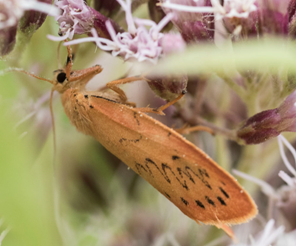
Several Purple Hairstreaks are around including one that is taking nectar from Hemp-Agrimony, the first time I have seen this species on a flower. Again there is no sign of the Painted Lady or Silver-Washed Fritillary and the most numerous butterfly species is once again the Gatekeeper. One marvellous find is to see a pinky-orange shape moving in some Hemp-Agrimony flowers. I have an inkling I know what this is after noting the colour of this moth as it proves to be because it is a beautiful Rosy Footman, the first I have ever seen and then another Jersey Tiger moth is also seen again on Hemp-Agrimony (up to three have been around Peg Pond in the second week of August). Hoverflies are not that common although several Eristalis species, a Xylota sylvarum and Myathorpa florea are all seen, with the latter being mainly found in one spot in the Bog Garden. No Volucella put in an appearance which is a bit of a disappointment.
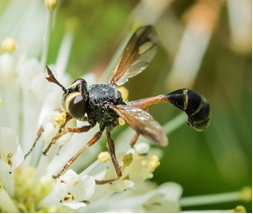
What is not a disappointment is to see another Sicus and better still is to find another species of Conopid fly that appears to be longer and thinner than Sicus yet still has the typical hooked abdomen. It rapidly disappears but only after I get a couple of record shots. The photographs are poor but show that the second abdominal segment is thin and elongated and that means this is Physocephela rufipes, a rather distinctive species. On the Gipsywort beside the open area of Peg Pond a small black crane-fly is noted but it is not actually a crane-fly but is actually from a different family with a similar shape and it is from the genus Ptychoptera.
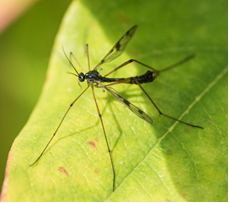
Bird-wise I have not taken my long lens out today because of the temperature and additional weight so of course several Green Woodpeckers allow a relatively close approach and on Peg Pond there are Mallard and Tufted Duck females with chicks, the latter may be off Thomson Pond where yesterday the Park workers had dredged the swallow pond turning the water somewhat murky. Apparently there are fledgling Sparrowhawks in the Plantation but they are not showing very well although they are often heard squawking loudly.
The heat is oppressive and so the walk home seems to take longer than normal and it is really hot in the couple of one hundred yard stretches that have no shade despite wearing a hat.
So July comes to an end along with this diary because I think we can say social isolation is currently over, at least in the South of the country, several Northern areas are back under restrictions due to the rising rate of Covid-19 infections. It has been a fascinating four months with many highlights and many insects seen that I have not expected to see. Of course I will not stop taking photographs of insects in August even if their numbers are dropping but the recording will be more ad-hoc, if done at all.
Identifying some of the insects has been easy but others have been a learning experience and a bit of a challenge and some still remain un-identified because I lack the knowledge and skill to identify them. Some are identified to genus only because of the requirement to look at genitalia or other microscopic details that are not readily visible from photographs but I have done the best I could.
However it is not all about the species list and the overall experience also has to be borne in mind. Seeing Nuthatches, Fallow Deer rutting, Purple Hairstreaks in profusion, a Bronze Sap Hoverfly, a Bagworm, long-horned moths Nemophora degeerella dancing, Kestrels nesting, naming five species of Nomad Bee and seeing the beautiful Ashy Mining Bee are all now wonderful memories of the lockdown period but of course there has to be a true highlight and it could have been finding a Silver-Washed Fritillary in Richmond Park or seeing so many Purple Hairstreaks or coming across so many Conopid flies which would have been my winner if it had not been for that extra-ordinary bit of luck turning right instead of left one day at Ham Gate and finding the White-Letter Hairstreak. That truly is my highlight of the last four months and without doubt will be the highlight of my natural history year because there is not much that will beat it! Although if I find a Brown Hairstreak that might…
 Leave a comment about this comment
Leave a comment about this comment